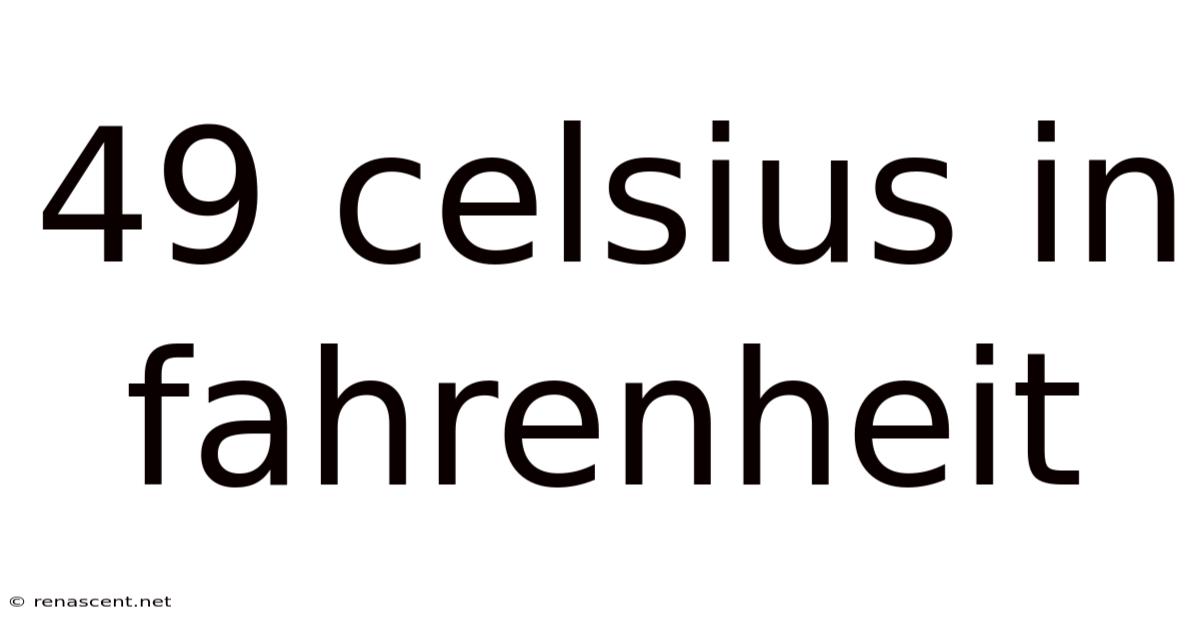49 Celsius In Fahrenheit
renascent
Sep 15, 2025 · 5 min read

Table of Contents
49 Celsius in Fahrenheit: A Comprehensive Guide to Temperature Conversion and its Implications
Converting Celsius to Fahrenheit, or vice versa, is a fundamental skill in many fields, from cooking and meteorology to engineering and medicine. Understanding these conversions is crucial for accurately interpreting temperature readings and making informed decisions. This article will delve deep into converting 49 degrees Celsius to Fahrenheit, exploring the calculation, its practical implications, and answering frequently asked questions. We'll also touch upon the broader context of temperature scales and their significance.
Understanding Celsius and Fahrenheit
Before diving into the conversion of 49°C to Fahrenheit, let's quickly review the two temperature scales.
-
Celsius (°C): This is a metric scale, widely used globally, where 0°C is the freezing point of water and 100°C is its boiling point at standard atmospheric pressure.
-
Fahrenheit (°F): Predominantly used in the United States, the Fahrenheit scale sets the freezing point of water at 32°F and its boiling point at 212°F.
Calculating 49 Celsius in Fahrenheit
The formula for converting Celsius to Fahrenheit is:
°F = (°C × 9/5) + 32
Let's apply this formula to convert 49°C:
°F = (49 × 9/5) + 32
°F = (88.2) + 32
°F = 120.2
Therefore, 49 degrees Celsius is equal to 120.2 degrees Fahrenheit.
Practical Implications of 120.2°F (49°C)
A temperature of 120.2°F (49°C) signifies a significantly high temperature. Understanding its implications depends heavily on the context:
-
Human Body Temperature: A body temperature of 49°C (120.2°F) is extremely dangerous and represents a life-threatening hyperthermia. Immediate medical attention is crucial. This level of fever indicates a serious underlying condition requiring urgent care.
-
Weather: 49°C (120.2°F) is an extremely high air temperature, characteristic of heat waves in desert regions. Exposure to such temperatures can lead to heatstroke, dehydration, and other serious health problems. Safety precautions, such as staying hydrated, limiting exposure to direct sunlight, and seeking shade, are vital.
-
Cooking: This temperature is commonly used in cooking, particularly for certain baking and deep-frying techniques. Precise temperature control is essential in achieving desired results and ensuring food safety. Thermometers are indispensable tools in this context.
-
Industrial Processes: Many industrial processes involve high temperatures, and 49°C (120.2°F) may be encountered in various applications. Understanding and managing temperature in such settings is critical for safety, efficiency, and product quality. Proper safety equipment and protocols are mandatory in these high-temperature environments.
The Significance of Accurate Temperature Measurement
The accurate conversion and measurement of temperature are vital for various reasons:
-
Safety: In many applications, accurate temperature monitoring is crucial for preventing accidents and ensuring safety. This is particularly important in industrial settings, where high temperatures can pose significant risks.
-
Quality Control: In manufacturing and other industries, temperature plays a critical role in product quality. Precise temperature control ensures consistent product quality and prevents defects.
-
Research and Development: Accurate temperature measurements are essential in scientific research and development, enabling accurate experimentation and data analysis.
-
Healthcare: Temperature monitoring is a critical aspect of healthcare, enabling the diagnosis and treatment of various illnesses. Accurate temperature readings are crucial for effective medical care.
-
Environmental Monitoring: Accurate temperature measurements are crucial for understanding and monitoring environmental changes, contributing to climate research and environmental protection efforts.
Different Temperature Scales and Their Uses
While Celsius and Fahrenheit are the most common scales, other scales exist, each with its specific applications:
-
Kelvin (K): This is an absolute temperature scale, where 0 K represents absolute zero – the theoretical absence of all thermal energy. It's frequently used in scientific contexts, particularly in physics and thermodynamics.
-
Rankine (°R): Similar to Kelvin, Rankine is an absolute scale, but it's based on the Fahrenheit degree. It's less commonly used than Kelvin.
Frequently Asked Questions (FAQs)
Q1: How do I convert Fahrenheit to Celsius?
A1: The formula for converting Fahrenheit to Celsius is: °C = (°F - 32) × 5/9
Q2: Are there any online calculators for temperature conversion?
A2: Yes, many websites and apps offer free online temperature conversion calculators. These tools can quickly and easily convert between Celsius and Fahrenheit, and other temperature scales.
Q3: What are the potential errors in temperature measurement?
A3: Potential errors in temperature measurement can arise from various sources, including instrument calibration, environmental factors, and human error. Regular calibration of instruments and proper measurement techniques are crucial for minimizing errors.
Q4: Why is it important to understand different temperature scales?
A4: Understanding different temperature scales is essential for effective communication and accurate interpretation of information across different contexts and geographical regions. It's particularly crucial in fields involving international collaboration or the use of data from various sources.
Q5: What is the significance of absolute zero?
A5: Absolute zero (0 K or -273.15°C) is the lowest possible temperature. At this temperature, all molecular motion theoretically ceases. It's a fundamental concept in thermodynamics and has significant implications for various scientific fields.
Conclusion
Converting 49°C to 120.2°F is more than a simple mathematical calculation; it’s a gateway to understanding the practical implications of temperature in diverse contexts. From the life-threatening implications of hyperthermia to the precise control needed in culinary arts and industrial processes, the accurate interpretation of temperature is paramount. A thorough understanding of temperature scales, conversion methods, and potential sources of error is essential for safety, accuracy, and effective communication across various disciplines. Remember always to prioritize safety when working with high temperatures and to utilize appropriate safety equipment and procedures.
Latest Posts
Related Post
Thank you for visiting our website which covers about 49 Celsius In Fahrenheit . We hope the information provided has been useful to you. Feel free to contact us if you have any questions or need further assistance. See you next time and don't miss to bookmark.